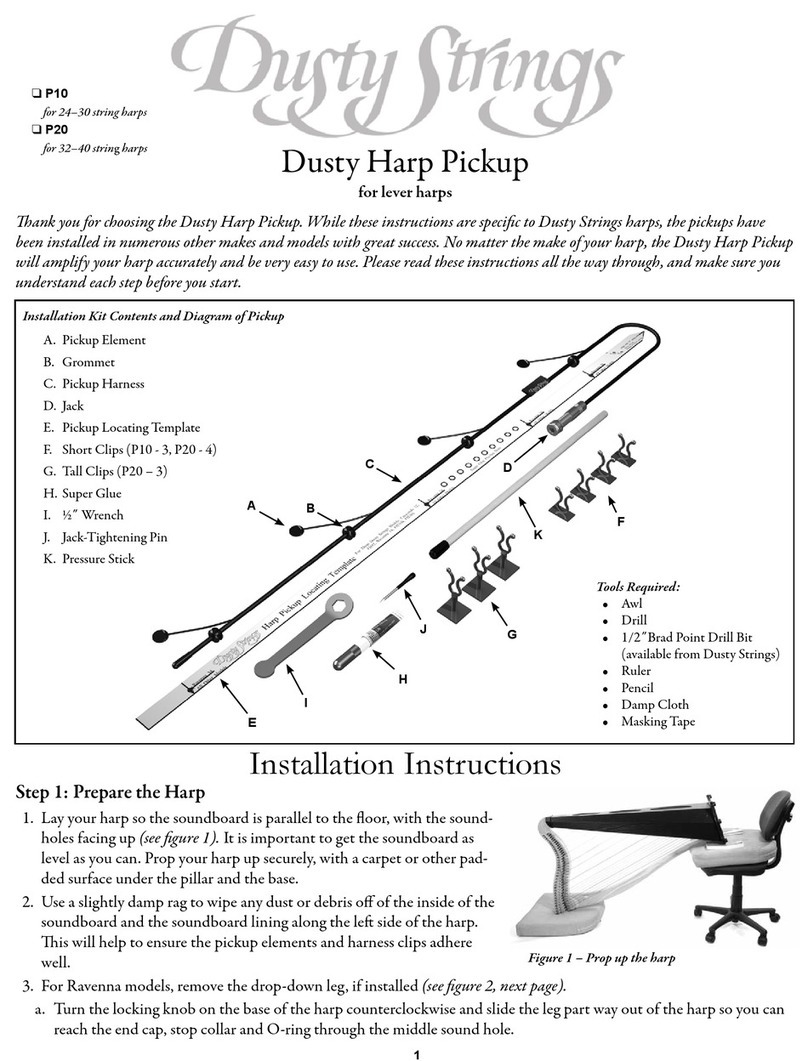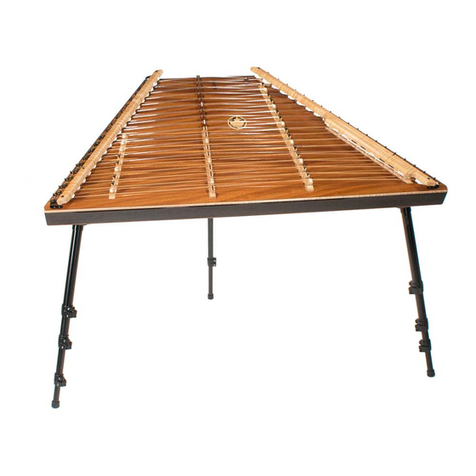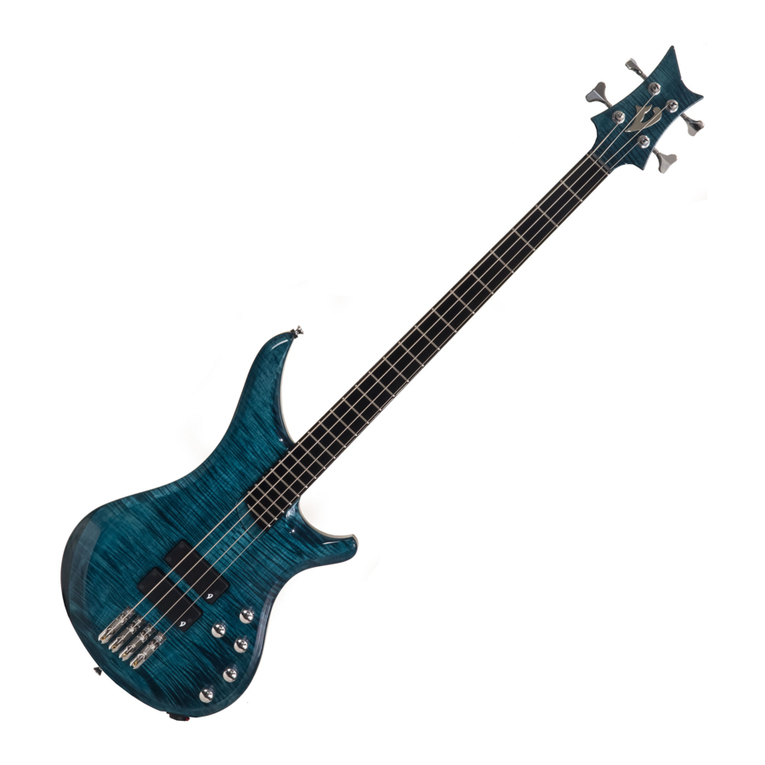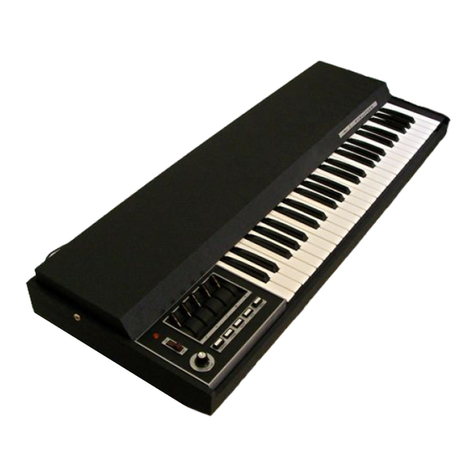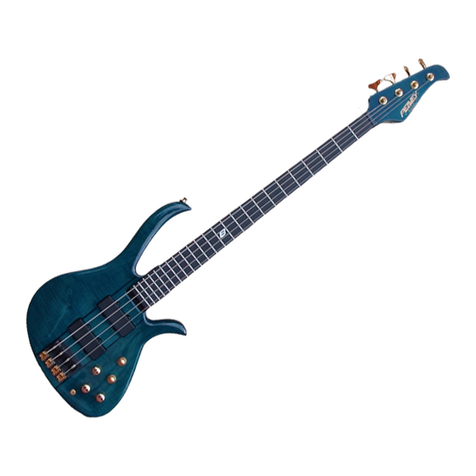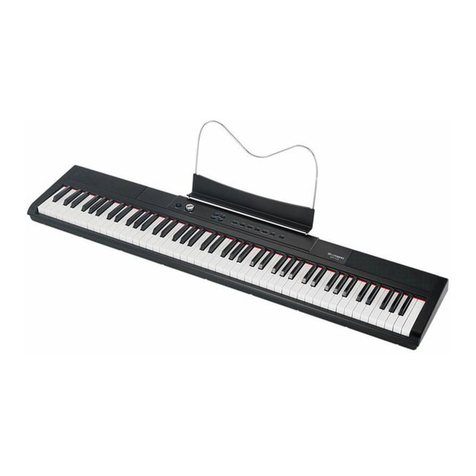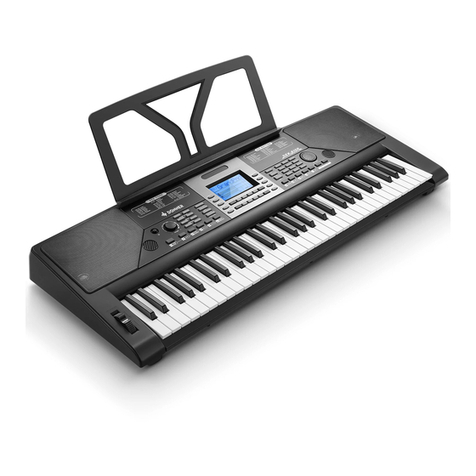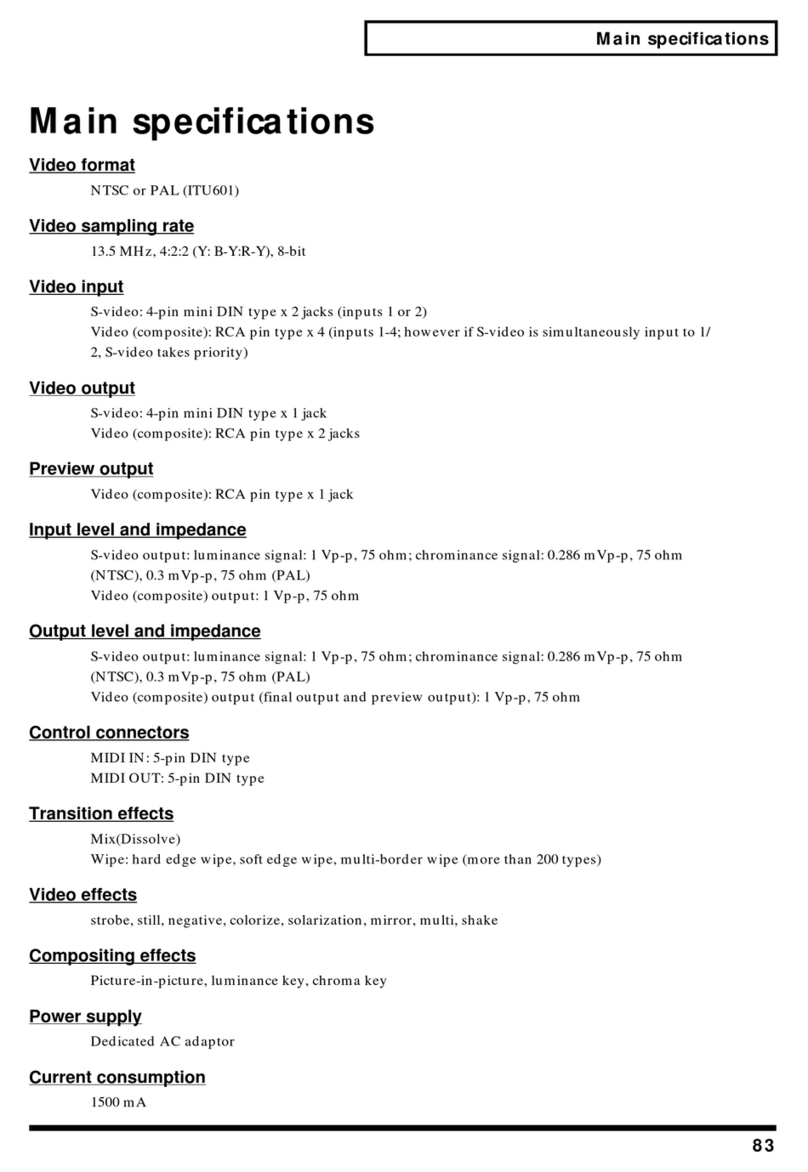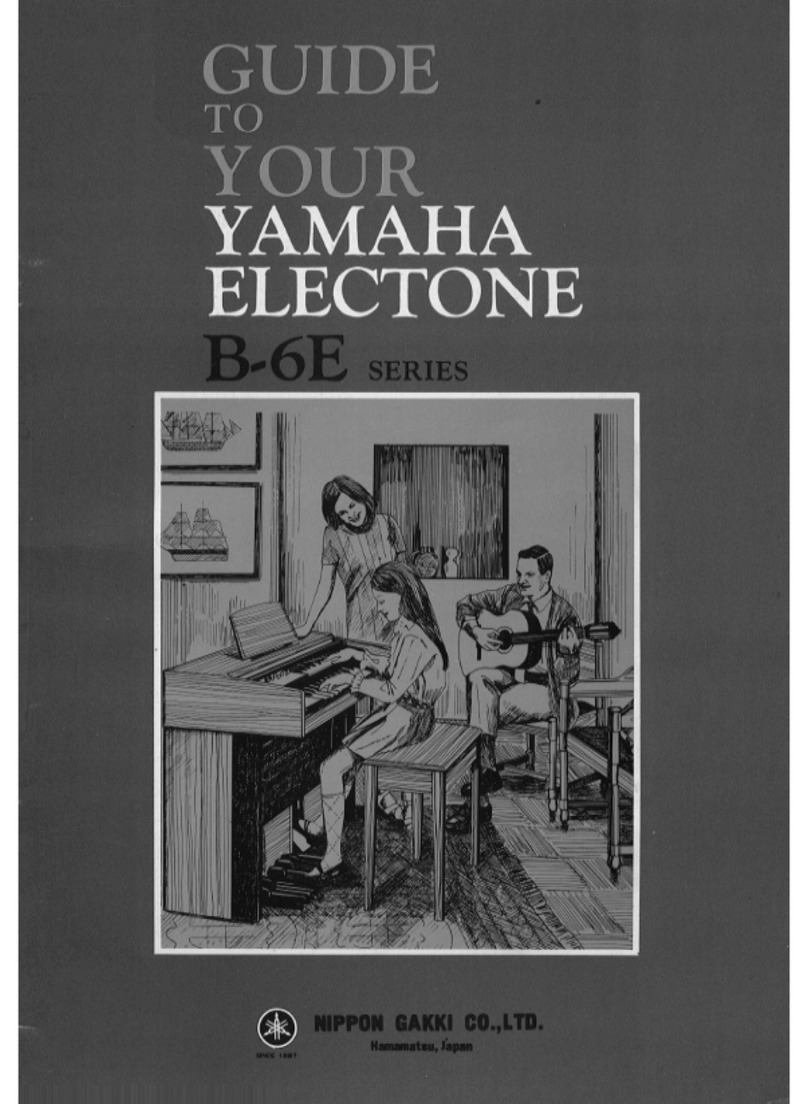Dusty Strings Hammered Dulcimer User manual

H
D
O’
G

Dusty Strings Company
Founded in 1978, Dusty Strings is a company of dedicated instrument build-
ers whose love of wood, fine craftsmanship, and music results in some of the finest
hammered dulcimers and harps available. We invite you to write or call us any time
with questions you may have, or simply to let us know about yourself and your
dulcimer. We hope your Dusty Strings hammered dulcimer will provide you with
many years of musical enjoyment.
© 1998 Dusty Strings
3450 16th Ave. W. • Seattle, WA 98119 • (866) 634-1656
www.dustystrings.com

Rev . 7/11/13
Contents
Introduction and History ....................................................................................... 1
Anatomy of the Hammered Dulcimer.................................................................... 2
Maintenance and Care of Your Dulcimer ............................................................... 2
String Maintenance......................................................................................... 2
String Types .................................................................................................... 3
Replacing Broken Strings ................................................................................ 3
Restringing the Whole Dulcimer..................................................................... 4
String Buzzes................................................................................................... 4
Finish.............................................................................................................. 5
General Care................................................................................................... 5
If You Live in a Dry or Cold Climate .............................................................. 5
Transporting Your Dulcimer ........................................................................... 6
Warranty Repair.............................................................................................. 7
Scales, Bridges, and Tuning Schemes ...................................................................... 7
Scales .............................................................................................................. 7
Treble Bridge Placement.................................................................................. 8
e Dulcimer Tuning Scheme......................................................................... 8
Tuning the Hammered Dulcimer ........................................................................... 9
Using Electronic Tuners .................................................................................. 9
Primary Concerns ........................................................................................... 9
Pitch ............................................................................................................. 10
Tuning by Ear ............................................................................................... 10
Tuning Hints ................................................................................................ 12
Playing Your Dulcimer ......................................................................................... 13
Positioning the Instrument............................................................................ 13
Hammers...................................................................................................... 13
Playing.......................................................................................................... 14
Contact Us........................................................................................................... 15

1
H D O’
G
Introduction and History
As a new owner of a Dusty Strings hammered dulcimer, you might want to
take a few minutes to read through this booklet. We have written it assuming
that you have little prior knowledge of the hammered dulcimer and of our instru-
ments. e intent of this booklet is to help familiarize you with the history, tuning,
care, and basic playing techniques of the hammered dulcimer. We hope it will
answer many of your questions and help you get to know your instrument and its
terminology.
First, a few words about the history of the hammered dulcimer. Some people
are surprised to learn that the hammered dulcimer is not a new instrument. In
fact, it’s been around longer than most modern instruments, and is thought to
have originated in the Near East thousands of years ago. Its descendants include
the harpsichord and piano. Nearly every culture throughout the world has some
form of this instrument, ranging from the large Hungarian cimbalom to the fragile
Chinese yang chin.
e hammered dulcimer was probably brought to America by early settlers
from Europe. It was a popular instrument at square dances, and its easy portability
earned it the name “lumberjack’s piano” in logging camps. In the late 1800s and
early 1900s factories were producing hammered dulcimers in quantity, and their
popularity had reached a zenith. Use of the instrument declined after the turn of
the century, and the hammered dulcimer became a rarity until the 1970s, when a
revival of interest in folk music focused attention on it once again. Today people are
rediscovering the unique and pleasant sound of this instrument and the relative ease
of learning to play.
e term “dulcimer” comes from the Latin and Greek roots “dulce” and “me-
los”, which combine to mean “sweet tune.” e hammered dulcimer is completely
unrelated to the “Appalachian” or “mountain” dulcimer, which has three or four
strings and is strummed.

2
Anatomy of the Hammered Dulcimer
Maintenance and Care of Your Dulcimer
String Maintenance
One advantage of the hammered dulcimer is that it is virtually maintenance-
free. With a minimum of periodic attention, your instrument will remain healthy
and sound beautiful for many years to come. While the strings of guitars and other
stringed instruments must be replaced often due to the corrosive effects of salt and
perspiration from the player’s fingers, the hammered dulcimer’s strings can last
many years with a little care. When tuning up, use a guitar pick instead of your
bare fingers to sound each string. If your dulcimer resides in a humid atmosphere,
you may notice a small amount of black corrosion or tarnish on the strings after
a while. Commercially available string wiping cloths work well for removing this
discoloration.

3
String Types
We use three types of strings on our dulcimers. Depending on the model,
your dulcimer will have strings that are plain steel music wire, phosphor-bronze, or
wound.
e steel strings seldom break under normal conditions and will sound good
for years. If you need to replace one, you can find a loop-end guitar or banjo string
of a matching gauge at most music stores, or you can purchase one from your dealer
or order one directly from us.
Phosphor-bronze strings are not as readily available. If you should require
replacements, your best bet would be to order them through your dealer or directly
from us. is type of wire has different physical properties than steel, and in some
situations provides a superior tone (as on some of the lower courses of the D45
model). However, there is a trade-off: phosphor-bronze has a lower tensile strength
than steel and “work hardens” (i.e., becomes brittle) with use, so it is subject to
more breakage than steel. If you like, you can try replacing a phosphor-bronze
string with a steel string of the same gauge, or perhaps one gauge thicker, and see if
you find the resulting tone acceptable.
Several of our models use wound strings on some of the bass courses. As time
goes by their tone will begin to dull, as with guitar strings, and they should be
replaced. It’s hard to notice the change because it is so gradual, so we recommend
choosing an easily remembered date on which to note whether a year has gone by
with the same wound strings. If so, you should treat yourself to some new ones.
All of these strings can be ordered individually or in spare string kits that contain
at least two of each size of string on your dulcimer (to cover most string breakage
situations).
Replacing Broken Strings
To replace a broken string, turn the string’s tuning pin counter-clockwise for
three or four complete revolutions and remove the broken sections of string. is
is important because the tuning pins have fine threads that cause them to descend
further into the pinblock with each turn. Place the loop of the new string over the
string’s hitch pin on the other side of the instrument and stretch it across to the
tuning pin, making sure it is sitting in position on top of its main bridge and is
passing through the appropriate hole in the opposite bridge. It is helpful to have
someone hold the loop end down on the hitch pin while positioning and stretching
the new string, but in a pinch you can devise something else to secure it your-
self —try a bulldog-type clip or rubber band.
Before you go any further, take a moment to look closely at an adjacent tuning
pin to see how the string coils neatly down the pin, with no excess wire sticking out
of the hole. is is what you’re going to imitate. e neat, tight coils look good and
ensure proper string positioning. Hiding the sharp end of the wire inside the pin
keeps it from puncturing your fingers.
Cut the string with wire snips (or sacrifice a pair of nail clippers), leaving two
inches of extra length past the tuning pin. Put the end of the string inside the hole
in the pin. Hold it there and turn the pin clockwise to form a sharp right-angle

4
bend. Keep tension on the string as it wraps onto the pin, so that it forms tight
coils down and away from the small starting hole. Make sure the whole string is
sitting in its correct position and is not caught up on any other pins, strings, or bridge
pedestals. e pin should rotate about three times before the string becomes taut.
Tune it slowly up to proper pitch. e whole process will seem awkward at first, but
becomes smooth with practice.
A new string will stretch a bit before stabilizing, so you may need to tune it a
few times in its first hour of service.
Restringing the Whole Dulcimer
Depending on atmospheric conditions, a string set can last a long time, some-
times even years if there are no wound strings. Wound strings typically get dull-
sounding within a year or so and need periodic replacement (see String Types, page
3). It is really an issue of personal preference when (or if) you replace the whole set
of strings on your instrument. If they get dark and corroded-looking, and seem to
have lost their “singing” quality, it may be time. You can go to your local dealer and
inquire about re-stringing, or dig into it yourself. It is really very straightforward,
though time-consuming.
e only important thing to know about this process is that it is best to take
off and replace only one course (two strings) at a time. is allows you to maintain
tension on the instrument, and you can get it back to holding pitch more quickly.
Also, you maintain bridge placement, which protects you from having to fiddle
around with re-setting the treble bridge in its precise fifth-interval tuning placement
(see Tuning Hints on page 12). You can follow the instructions above for how to
take off the old strings and put on the new ones.
If, however, you want to give the soundboard a thorough cleaning as well as
changing the strings, you may want to remove all the strings at once, as well as the
bridges. Make sure you carefully mark the placement of the bridges (we suggest using
tape for this purpose) before you remove all the strings. e bridges are not glued down
and will need to be replaced exactly if the instrument is to be tunable. Before cleaning
the soundboard, please read the section below on your instrument’s finish.
String Buzzes
If you hear a raspy, buzzing sound when you play your instrument, a string is
probably resting too lightly on a side bridge so that it vibrates against the bridge
when it is struck. If you suspect that this is happening with one of your strings,
press down on the string right next to the tuning pin and strike the string. If the
buzz is gone, you’ve found the culprit, and you can permanently silence it by
lowering the string so that it makes solid contact with the side bridge. Do this by
loosening the tuning pin about half turn while pushing the string down toward the
pinblock. Hold this position as you re-tighten the tuning pin. is same remedy
may apply to string buzzes on the hitch pin side. In the case of some of the higher,
right-side bass bridge strings, the opposite solution may be required: you might find
places where it seems easier to raise the string on the tuning pin and completely
eliminate contact with the side bridge. is works only because the string sections
to the right of the bass bridge are not used for playing.

5
Finish
Depending on which model you’ve chosen, your instrument is finished with
either black or clear semi-gloss lacquer. In both cases, caring for the finish requires
nothing more than a gentle wipe-down with a soft cloth, lightly dampened with
glass cleaner to remove fingerprints. Using instrument or furniture polish or oils is
not necessary or recommended. ey are hard to wipe off adequately, tend to attract
and hold dust and grime, and can interfere with lacquer bonding if you ever want
finish repair work done in the future. It is better to just keep your hammered dul-
cimer dust-free using a feather duster and a 2” or 3” soft-bristle paintbrush, which
works especially well for getting dust out from between the hitch and tuning pins.
e soundboard can be cleaned with a sock stuck over the end of a yardstick.
Compressed air is also effective if the dust is loosened first with one of these other
tools. If your instrument is out of its case for long periods, a dust cover made of soft
fabric will help keep it clean. For long-lasting beauty, the best thing you can do is
keep the instrument dusted. Accumulated dust attracts and holds moisture and oils
and eventually becomes very hard to remove.
General Care
Be sure to guard your hammered dulcimer from extreme changes in humidity
and temperature. Keep it out of direct sunlight, hot cars, freezing attics, etc. Many
people do not know the speed with which a car interior becomes dangerous to
instruments. Because pets are vulnerable to the same dangers, the Humane Society
publishes the following, somewhat surprising, details: on an 80 degree day, a car
parked in the sun or the shade with the windows cracked will reach 102 degrees in
10 minutes and 120-160 degrees in 30 minutes.
Many instrument glues begin softening and melting at around 130 degrees.
Once softened, glue loses its holding power, and any instrument under string ten-
sion is at risk of pulling apart. You could conceivably open the car door to find your
instrument in pieces. More likely, you would have unknowingly softened the glue
to the point where a slow and gradual disintegration of your instrument begins, the
results of which won’t show until much later. Basically, expect that your instrument
will be comfortable anywhere you are, and not where you’re not. So, take it into the
restaurant with you! It’s also smart to travel with your dulcimer in a case that offers
insulation (such as our cordura and foam cases) to protect it from quick changes in
temperature.
If You Live in a Dry or Cold Climate
If your weather gets dry or cold, and your instrument has a solid wood sound-
board, you should take steps to safeguard your instrument from cracking. Damage
caused by excessive dryness is not covered by your warranty, because it is something
over which we, as a manufacturer, have no control.
Here is a brief description of what happens to your instrument when the rela-
tive (or atmospheric) humidity changes. Within a week, the moisture content of
the wood will change to match that of its surroundings. If the humidity increases,
the wood will take on moisture and swell. If it swells too much, it can warp. If the
humidity drops, the wood will lose moisture in a matter of days and shrink. If it

6
shrinks too much, it will crack. Instruments with large soundboards, including
hammered dulcimers, are more vulnerable to the dangers of swelling and shrinking
than those with small soundboards (such as guitars or violins). So don’t assume that
because your guitar has done fine in your climate, your hammered dulcimer will
too!
e challenge for the instrument builder is to make a soundboard that can
accommodate the widest possible variation in humidity without problems. Before
we glue up a hammered dulcimer, we equilibrate the soundboard and back in a con-
trolled environment to a relative humidity of 43% to 45%. Our years of building
these instruments and recording humidity data have shown that this approach ac-
commodates the widest range of real-world humidity conditions without problems.
As is true with most wooden musical instruments, your instrument will be happiest
in a relative humidity range between 40% and 50%. It may do all right outside that
range, but the farther you go in either direction, the greater your risk of damage.
So if you live in a dry climate, or are experiencing a cold spell, you should
humidify your instrument, either by keeping it in a humidified room or by using an
instrument humidifier.
If you humidify the room, or your house, the only way to be certain your hu-
midifier is maintaining a safe range is to place a hygrometer (a device that measures
relative humidity) near your instrument and monitor the readings. Inexpensive
hygrometers can be purchased from Dusty Strings or from many music stores. Give
us a call if you need help finding one.
If you do not have a hygrometer, or if your room humidifier is not sufficient,
you should store your instrument in its case with an instrument humidifier. ese
are also available from Dusty Strings or most music stores. Put your dulcimer back
in the case with the humidifier when you’re not playing. Check that the humidifier
is still moist. Rapid swings from dry to moist are hard on any instrument. Once the
ambient humidity reaches a safe range, around 40%, take the humidifier out. Too
much moisture will cause swelling and warping.
Keeping your instrument properly humidified is an excellent way to ensure
longevity, and is really the only type of maintenance that your hammered dulcimer
requires beyond tuning, cleaning, and replacing an occasional string.
Transporting Your Dulcimer
We have padded, zippered, cordura cases with shoulder straps to fit all our
hammered dulcimers. ese work quite well for protecting your instrument from
dents and dings in most transport situations. In car travel, just be sure to load the
dulcimer on top of your other gear, bridge side up, where it won’t shift; or stand it
on its top rail (with case handle up), braced so it can’t fall over. If you’re driving for
a distance with the sun beating down through the windows, throw a space blanket
over your dulcimer to reflect the sun. e temperature under the blanket will stay
10-20% cooler. Please be sure to read about the danger of leaving your instrument
in a parked car under General Care (page 5).

7
Flying with your dulcimer can be a challenging proposition. Some people who
fly with their hammered dulcimers a great deal have custom flight cases made, but
we’ve found these to be quite expensive and very heavy. One resource is the Colo-
rado Case Company at 800-340-0809 or on the web at www.coloradocase.com.
ey make a sturdy and lightweight rigid foam case that works well.
You may find that the easiest way to protect your dulcimer for the occasional
air trip is to pack it up as though you were going to ship it via UPS, and check it
with your other luggage. is entails finding a box big enough to fit the dulcimer
in its case, with a few inches of extra padding all around. Use soft foam or starch
packing beans, and pack it snugly so the instrument can’t shift around. For a smaller
dulcimer, sometimes a left-over guitar shipping box from your local music store will
work. For larger instruments, you may need to find a box at a packing service. If
your dulcimer was shipped to you, and if you have room, it can be a good idea to
keep the box it came in.
Warranty Repair
Our instruments carry a five-year warranty to the original purchaser. Be sure
to send in the warranty card to register your purchase. If we don’t have that on file,
you may need to provide proof of purchase for warranty service. If you have any
warranty questions, please contact the store where you bought your instrument if
possible. ey may be able to help you assess whether the problem is covered under
warranty, and/or whether it might be repaired locally, thereby avoiding shipping
costs and minimizing the time you spend without your instrument. If you need to
return your instrument to us for evaluation and repair, call us first for approval (if
your dealer hasn’t already done so). Package your instrument as described in the
previous section and ship it pre-paid and insured. Enclose a description of the prob-
lem and any circumstances that may be linked to the problem (e.g. falls, accidents,
weather conditions, etc.). If you did not send in your warranty card to register your
purchase, you must also enclose a copy of your purchase receipt.
Scales, Bridges, and Tuning Schemes
A knowledge of the dulcimer’s tuning scheme and of major scales, as well as
a general understanding of treble bridge placement, will be of great help in the
playing (and tuning!) of your instrument. is section applies to the traditional
fifth-interval tuning. If you have a piano dulcimer (our model PD40), some of this
information will not be relevant, and some will need to be adapted to your instru-
ment.
Scales
Quite simply, a major scale is any series of eight notes which sound like the fa-
miliar “Do Re Mi Fa Sol La Ti Do." Such a series has a special relationship between
all the notes in the scale. e important concept is that a major scale can begin
on any note, and as long as the intervals between the notes are maintained, it will
still sound like “Do Re Mi...." e note on which a major scale begins is called the
“root” or “tonic,” and names the key you are playing in.

8
Treble Bridge Placement
e interval between the fi rst note of a major
scale (Do) and the fi fth note of the scale (Sol) is called
a “fi fth”. e treble bridge of a dulcimer is precisely
positioned to divide the strings that pass over it into
two sections that sound notes one fi fth interval apart.
is means that if a string sounds “Do” on the right
side of the bridge, then that same string
will sound “Sol” on the left side. is fi fth-
interval relationship is clearly illustrated
by singing the fi rst two words of Twinkle,
Twinkle, Little Star.
The Dulcimer Tuning Scheme
e hammered dulcimer is laid out
in simple patterns of major scales. It is
designed to provide easy access to the
scales, or keys, most commonly used in
playing traditional music: D, G, C, F, and A.
e diagram to the right illustrates the tun-
ing scheme for our basic 12-treble/11-bass
course instruments (the D10, Apprentice,
and Prelude).
e large dots in the diagrams show
where major scales begin, or would begin if
the notes continued on in their established
patterns. ese positions should be clearly
marked on your instrument by the white
bridge cap markers. You play on both sides
of the treble bridge and the left side only of
the bass bridge. To play a major scale starting
on the bass bridge, start at a white marker
and play up the bridge to the next white marker.
en cross over to the treble bridge to the white
marker that’s across from the note you started
on. To start a scale on the treble bridge, start at
a white marker and play on the right side of the
bridge. Play up to the next white marker, and
then cross over the bridge and down to the same white marker you started on. See
the numbers in parentheses on the two upper charts on this page.
Become familiar with these patterns and then fi nd all of the scales listed earlier.
Because the dulcimer is made up of a series of scales built one on top of the other,
there are many notes that are repeated. is allows greater freedom of choice with
playing patterns, and can help speed the tuning process.
D Major: D E FTG A B CTD
G Major: G A B C D E FTG
C Major: C D E F G A B C
F Major: F G A BIC D E F
(8) Do •Fa (4)
(7) Ti Mi (3)
(6) La Re (2)
(5) Sol •Do (1)
Treble Bridge
•Do (8)
Ti (7)
La (6)
•Sol (5)
Bass Bridge
Treble Bridge
(4) Fa •
(3) Mi
(2) Re
(1) Do •
Bass Bridge
C''
BI' •
A'
G'
F' •
E'
D'
C' •
B
A
G •
D''' G''
C''' •F''
B'' E''
A'' D''
G'' •C''
F#'' B'
E'' A'
D'' •G'
C#'' F#'
B' E'
A' •D'
G#' C#'
Treble Bridge

9
Tuning the Hammered Dulcimer
As with any stringed instrument, learning to tune the hammered dulcimer is an
important part of learning to play. e more critical you become of the tuning, the
more you will appreciate a finely tuned instrument. It may take a while to develop
the techniques that speed the process up, but don’t get discouraged and let tuning
become a burden. You owe yourself the pleasure of playing on a properly tuned
instrument, and your satisfaction in owning and playing your hammered dulcimer
will be greatly enhanced if you allow yourself the time to keep it in proper tune.
e following discussion of tuning is fairly detailed and assumes no prior expe-
rience. If you do have some experience with tuning, you may want to skim through
this section, keeping your eye out for idiosyncrasies peculiar to the hammered
dulcimer.
Using Electronic Tuners
Electronic tuners are by far the most popular, accurate, and easy-to-use tuning
aids. ese small, battery powered devices “listen” to the pitch of the string and tell
you with a meter or light just how sharp or flat the string is. All you have to do is
adjust the string until the tuner tells you its pitch is correct. We recommend getting
an electronic tuner as soon as your budget allows. With a little practice you will be
able to quickly put your dulcimer in tune, and can spend your time playing music!
Tuning Sequence. When using an electronic tuner, it really doesn’t matter
what note you start with. A common practice is to start on the lowest bass course
and work up the bass bridge to the top, then go to the lowest treble course and
work up to the top of that side of the bridge. e notes on the other side of the
treble bridge will come into tune automatically. With this methodical approach, it’s
easy to keep track of where you are.
Primary Concerns
Difficulty of tuning. e dulcimer is no more difficult to tune than other
stringed instruments. e basic goal of matching the pitch of a string to a certain
note is exactly the same. e difference, of course, is that the dulcimer has more
strings than most. However, there are a number of special procedures and shortcuts
that make the task much easier than it may initially seem. Learning to tune the
instrument is something that comes with practice. Despite initial fears, anyone can
learn to adequately tune this instrument.
How long will it stay in tune? ere is great variation in the length of time
an individual instrument will hold its tune. Generally, what makes an instrument
go out of tune is temperature change. Heat expands the metal strings, causing their
pitch to drop or go flat, and cold can cause the opposite problem. Wood compres-
sion, settling of the instrument, and the strings stretching over time can also cause
a hammered dulcimer to go flat. is is why a new instrument, or one that is newly
strung, will go out of tune more quickly than a seasoned instrument.
Your dulcimer should stay in tune fairly well if the environment is relatively
stable. And, fortunately, instruments tend to drop in pitch uniformly across their
range, meaning that they may remain in tune with themselves and playable for a
longer period, as long as you aren’t trying to play with someone else!

10
How to best keep it in tune. Any action that minimizes temperature variation
will help. Don’t keep your instrument near a wood stove, heating duct, or large win-
dow. Put it in a well-insulated case when moving from one environment to another,
and give it time to adjust slowly to the new temperature before removing it from
the case. Avoid or minimize playing in the hot sun. Basically, keep in mind that
temperature change, and the rate of change, will have an effect.
Do not, however, feel that you have to keep your dulcimer in its case when
not in use. We believe that the more accessible your dulcimer is, the more you will
play. We suggest you get a playing stand so your dulcimer will be out in your home
where you can enjoy it.
Dealing with a new or very out-of-tune instrument. e large number of
strings on a dulcimer exert a tremendous amount of tension. If an instrument is
new or far out of tune, the additional tension needed to bring it up to pitch will
cause a slight compression of the whole instrument. is may be significant enough
that by the time you tune all the strings, the ones you started with will be flat again.
In this situation you may have to tune the entire instrument two or three times. To
save time, do an approximate job the first time or two, and save fine-tuning for the
last time around. is is seldom necessary with seasoned instruments that have been
kept in tune.
Pitch
When a string is struck it vibrates, creating waves in the air, much like ocean
waves. ese waves strike your ear and are translated into what you hear as the
tone. e pitch of that tone depends on the frequency with which the sound waves
reach your ear (i.e., how many waves per second). Each note has a certain frequency
which is measurable and recognized. It is generally accepted that the A above
Middle C has a frequency of 440 waves or cycles per second. All other notes are
based relative to this frequency. “Concert” or “absolute” pitch is based on this A440
standard. Remember, though, that an instrument will still sound “in tune” when all
of its notes are pitched in the correct relationships to one another, even though the
entire range may be sharp or flat relative to concert pitch.
Tuning by Ear
Tuning standards. A tuning standard is whatever you use to match your pitch.
It can be an outside source or simply another string on your instrument. Perhaps
the most basic standard is the tuning fork, a metal device that vibrates at a certain
pitch when struck. Touching your soundboard with the non-forked end of a vibrat-
ing tuning fork will amplify the fork’s sound considerably.
Chromatic pitch pipes are inexpensive tuning devices that look like round
harmonicas and have all the notes— including accidentals (sharps and flats) —for
one complete octave. ey come in different ranges, the most useful being the
“C-to-C” model. If you can, get one with a note selector, a device that enables you
to blow a single note while holding the pipe with your lips, thus freeing both hands
for tuning.
Tuning to another instrument is another option. In fact, matching pitches
on your hammered dulcimer with another stringed instrument, such as a piano, is
sometimes easier than using a tuning fork or pitch pipe.

11
Matching pitches. e whole discussion of tuning really comes down to
matching pitches. You hear a note from your standard and tighten or loosen a string
to match it. is can be quite simple, and it can also be frustrating. e environ-
ment has a lot to do with it, both physically and psychologically. Tuning alone in a
quiet room is certainly easier than tuning on stage in a noisy tavern.
Many people fear tuning, and others think themselves incapable of it. Both of
these beliefs are usually unfounded. Nearly everyone can learn to match pitches.
Sometimes it takes a great deal of practice, but it is definitely a skill that can be
learned rather than an inherited gift. One thought to keep in mind: in addition to
tuning in order to practice, practice tuning.
When attempting to match pitches, you should be able to hear the standard
note while changing and sounding your string. Keep blowing the pitch pipe while
tuning — it is much easier than trying to remember the note. Once you hear the
standard note, there are only three possible conditions that exist: 1) your string is
flat (too loose), 2) your string is sharp (too tight), or 3) your string is in tune (just
right). e object of ear training is to learn to tell the difference between these three
conditions.
With your standard note droning in the background, change the pitch of your
string. Tighten it to make it obviously sharp, then slowly loosen it and listen as the
pitch gets lower, goes into unison with the standard, then drops into the obviously
flat range. Reverse the processs, and try other notes. Learn to tell the qualitative
difference between sharp and flat. Learn to recognize the two notes coming together
into unison. Some find it easier to hear two notes coming together when they start
flat and raise the string up to pitch. Get feedback from others. Pretty soon, you’ll
get the hang of it.
As you experiment, you may hear a curious kind of pulsation, or “wow-wow-
wow”, occurring as the notes get closer together. You can learn to use this phenom-
enon to aid your tuning. e “beats” will slow down as the two notes get closer and
closer to the same pitch, and will finally stop altogether when they’re in unison.
A musical interval is the distance between any two notes. e interval between
Middle C and the next higher C is an octave. is is an easy interval to hear and
match. If your standard note is one octave lower than the note you want, you can
still tune in just about the same manner as if it were the same (unison) note. Other
intervals, particularly the one between Do and Sol on a major scale, are also easy to
hear, and with practice you can use these intervals to speed up the process of tun-
ing.
Tuning Sequence. Now for the actual tuning. If you are using a pitch pipe,
the most direct method of tuning is to match all of the notes on the dulcimer that
are available on the pipe. Once you have gone through the single octave of notes on
the pipe, your knowledge of the tuning scheme will allow you to tune the remain-
ing notes. For instance, by tuning the G on the right of the treble bridge you have
also tuned the D on the left side. So now you can use this D to tune the D you
need at the upper right of the treble bridge. Similarly, you can get the next note, E,
by matching it to the E on the left side of the treble. You may have to use octave
intervals to get some notes. In fact, once you can hear octave intervals well, you can
simply use the pitch pipe to tune all of the notes on the instrument.

12
Tuning to a piano is a little easier. Just start matching pitches and keep going
until you get them all.
Some players can start with a single note from a tuning fork or pitch pipe,
and just “hear” when the rest of the notes are correct. is is usually done in scales,
starting with the “DO” and singing the notes in order. As your ear training pro-
gresses this may become a possibility for you.
One more option to consider is cross-tuning the instrument to itself. Explore
the possibilities that arise from the treble bridge placement, as discussed above:
when you tune the right-hand D you get an A on the left side. Use this A to tune
the A back on the right side, which in turn will give you an E on the left side. Use
this E to tune the E on the right side, and so on. It is possible to tune nearly the
entire instrument in this manner.
In conclusion, keep this thought in mind: if you can hear that it is out of tune,
you have the ability to learn to put it into tune!
Tuning Hints
Use a guitar pick to pluck the strings. It will make a crisp, loud sound, and al-
low you to isolate and tune one string at a time.
After tuning all, or part, of one side of the treble bridge, play the major scale(s)
over that bridge. If the scales don’t play true on both sides, the string(s) may be held
up by friction where they pass over the bridge cap, preventing equalization of ten-
sion on both sides of the bridge. e simplest solution is to lift the strings up off the
bridge to break any friction, then re-tune the left side of the bridge first, checking
the right side after. Some players will tune first the side of the treble bridge that is
farthest away from the tuning pins. en they can often fine-tune any out-of-tune
notes on the side of the bridge nearest the tuning pins without affecting the notes
already tuned on the other side. is technique acknowledges the friction between
string and bridge, and works with it. Learning to deal with string friction is just
a matter of experience and fooling around with your particular instrument. It
shouldn’t present a problem, but you can expect to encounter it occasionally.
If these techniques don’t cure an apparent imbalance between the right
and left sides of the treble bridge, it’s possible that the bridge, which is not glued
down, may have been knocked slightly out of position. Correct positioning is
critical for accurate tuning. To test for this, try the tuning/equalization of tension
procedure on the very top string over the treble bridge. If the left side remains
sharp when the right side is in tune, tap the top end of the bridge lightly toward the
right, and try the tune-up and test procedure again. If the left side is flat when the
right side is in tune, tap the end of the bridge to the left. You won’t need to move
it far to have an effect—a very small fraction of an inch will make the difference
between “in balance” and “out”. Do the same testing and re-setting procedure for
the bottom-most string on the treble bridge, and your bridge should be back in
position.
It is very important that the bridge be perfectly straight. Be careful not to intro-
duce a bow in the bridge by moving only its top and bottom sections. Check for
straightness by laying a straight edge, such as a ruler, along the bridge. If you detect
a bow or curve after carrying out the steps above, you will have to tap the center of
the bridge in the appropriate direction to straighten it out. If you are unsure about
this procedure, see your dealer or call Dusty Strings for assistance.

13
Playing Your Dulcimer
One of the nicest elements of the hammered dulcimer is its ability to turn even
the simplest melody into beautiful, full-sounding music. e inherently satisfy-
ing tone of the instrument combines with its resonance to produce an illusion of
sound — there seems to be more music coming out than the sum of the individual
notes. is is one of the appeals of the dulcimer and serves the beginner well, pro-
viding instant satisfaction with even the simplest tunes.
Of all the advice you’re likely to be given on playing the hammered dulcimer,
there is really only one important thing to remember: the dulcimer is a folk instru-
ment, and the essence of folk music is not technique, but personal enjoyment. We’ll
give you some specific instructions so you can get started playing right away, but
feel free to develop other styles. In folk music there are no absolutes —any way you
can get music out of the instrument is a good way to play.
Positioning the Instrument
Most players put the long side of the instrument toward them when playing.
It doesn’t make much difference if you sit or stand while playing, as long as you
can easily reach all the notes. If you set the instrument on the floor or on a table,
you will notice that tone and volume are expanded if the top edge of the dulcimer
is propped up so the back is free to resonate. Also, the dulcimer is more comfort-
able to play when it’s tilted toward you. Your instrument has a threaded insert built
into its back that allows you to attach a playing leg. A short leg props the dulcimer
up off a table-top at a comfortable slant. A long leg lets you play while sitting in a
chair, with the leg supporting the instrument in front of you and the bottom (long)
edge of the instrument resting on your knees. is is a very portable and inexpen-
sive way of supporting the instrument while you play. Setting it on a stand so the
back vibrates freely gives maximum volume and provides a consistent height no
matter where you play. It also allows you to keep your instrument out on display
where it’s more likely to invite you to play. Short and long playing legs are avail-
able, as are folding wooden stands and fully adjustable leg systems. Check with your
dealer or with us for more information.
Hammers
You will probably encounter all sorts of different hammers. e single-sided
hammers provided with most of our instruments are a good, well-balanced design
and construction, suited to all styles of playing. ey are made of bare hardwood
and will give the loudest sound. We also make a leather-padded version, which gives
a softer tone that is nice for mood and variety. Double-sided hammers, included
with our chromatic models, have both bare wood and leather covered playing
surfaces on one hammer. You’ll find that hammer preferences are a very individual
thing. Variations include double vs. single sided, padded vs. unpadded, types of
padding, length of hammer, type of wood, shape of handle and hammering surface,
weight, and balance. Try out as many as you can to see what suits you best. We
make two styles of single-sided hammers, both in bare wood and leather covered,
and two shapes of double-sided hammers. We also make double padded hammers,
with thin leather on one side and felt on the other.

14
Playing
You may initially have a problem focusing your eyes on the strings as you
play. Practice eases this fairly quickly. Tilting the top of the instrument toward you can
improve your perspective somewhat, the angle being purely a matter of preference. It is
helpful to focus on the black and white bridge caps where the strings cross the bridge,
rather than on the strings themselves. e bridge caps are easier to see and provide loca-
tion markers.
Hammers are generally held between the thumb and forefinger, and the strings
are struck about one inch from the bridge. Rock the hammers in your hands a few
times to get their feel, then strike a sharp blow to a note, stopping the action as the
hammer rebounds off the string. e striking motion should come from your wrist,
not your elbow. Keep this up until you can easily get a single, well-pronounced note.
If you hold the hammers a bit more loosely, put a little more pressure down with
your thumbs, and don’t stop the action after the first rebound, you will find that they
bounce off the strings in a sort of roll. is is a trill, a common embellishment.
A good way to start playing is to run through the major scales. You can refer back
to Scales, Bridges, and Tuning Schemes (page 8) for information on their location and
layout. Play with authority—use enough force to get the best tone from the instru-
ment. Timid playing may make your instrument sound brash, thin, or indistinct. As
you gain confidence, your accuracy and tone production will improve.
Although a great deal of instructional material is available for the hammered
dulcimer, probably the most common means of learning a song is by ear. You don’t have
to read music; just take a song whose melody is familiar and translate it into a hammer-
ing pattern. e easiest playing method is to alternate notes between the left and right
hands, though you may want to deviate from this once in a while to keep your hands
from getting in each other’s way. Start by taking a very familiar song, such as Oh Susan-
nah and learn your way around the strings by picking out the melody with one hand.
Simple tunes like these usually start on the tonic, or first note of the scale, of the key in
which you are playing (D for D major, G for G major, etc.). If the first note is not the
tonic, then try the third (“mi”) note of the scale. Next, play the tune while alternating
hands. Try to develop coordination in both hands so that you can use either hand as well
as the other. Experiment with putting in a few trills as you play.
With practice your reflexes will adjust to the distances between courses, the ham-
mers will become comfortable extensions of your hands, and your music will gain
rhythm and continuity. Here are a few more embellishments you’ll want to incorporate
in your playing:
Chords—hitting two notes simultaneously. e easiest combinations to find
involve the thirds, fifths, and octaves (DO, MI, SOL, DO).
Arpeggios—hitting in rapid succession the notes DO, MI, SOL, DO of any
scale, producing a nice full chord.
Drones—inserting between melody notes the “tonic” (DO) of the key you’re
playing in. is is like the bagpipe, which drones a constant note while playing the
melody. e mountain dulcimer also uses a drone note.
You can listen to live or recorded music for inspiration. ere are many record-
ings of dulcimer music available. ere is also an abundance of good self-instruction
methods, including books, book and CD sets, videos, and DVDs. See your dealer or
contact Dusty Strings for instructional materials. You can also subscribe to Dulcimer
Players News for quarterly information and articles about players, festivals, tunes, tech-
niques, recordings, and lots of other dulcimer-related things (www.dpnews.com).

15
Contact Us
We hope you enjoy your Dusty Strings hammered dulcimer. We carry lots of ac-
cessories and teaching materials that you might find useful: cases, stands and legs, sev-
eral types of hammers, books, DVDs, tuning wrenches, electronic tuners and more.
We can help with pickup installation if you want to amplify your dulcimer. Visit our
website at www.dustystrings.com.
Please call or email if you have any questions.
Dusty Strings
3450 16th Ave. W. • Seattle, WA 98119 • (866) 634-1656
Other manuals for Hammered Dulcimer
1
Table of contents
Other Dusty Strings Musical Instrument manuals
Popular Musical Instrument manuals by other brands
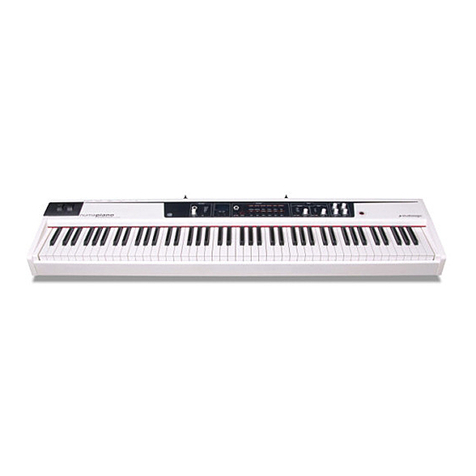
Studio Logic
Studio Logic NUMApiano Operation manual
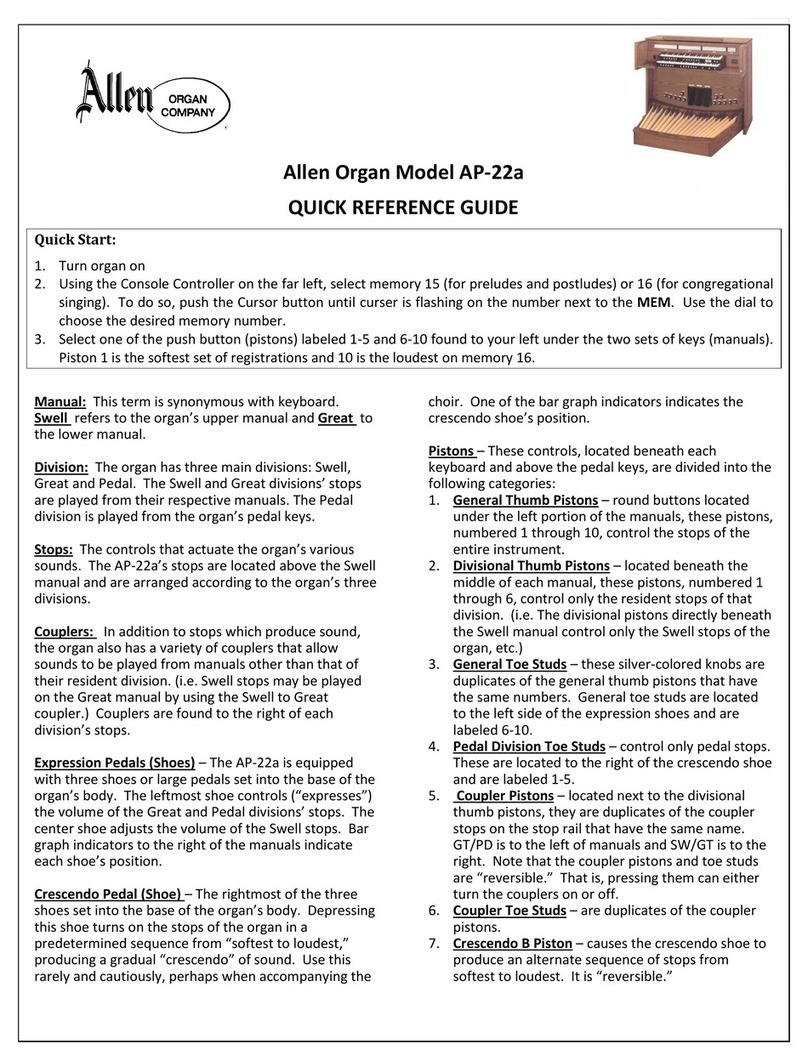
Allen Organ Company LLC
Allen Organ Company LLC AP-22a Quick reference guide

Studio Logic
Studio Logic Numa Piano Operation manual

Allen Organ Company LLC
Allen Organ Company LLC Q300T owner's manual

thomann
thomann Harley Benton TE-LH user manual
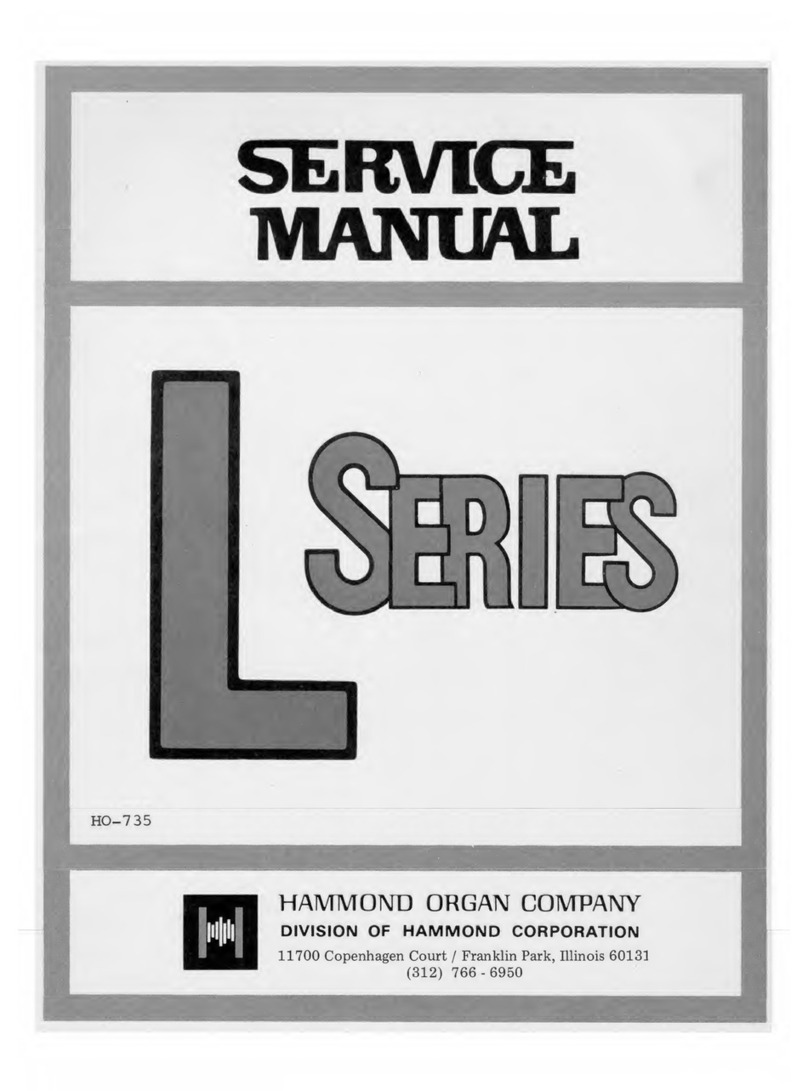
Hammond
Hammond L series Service manual
